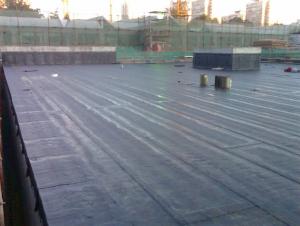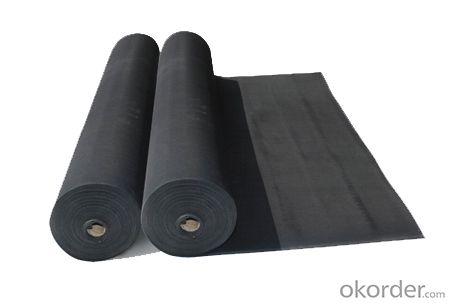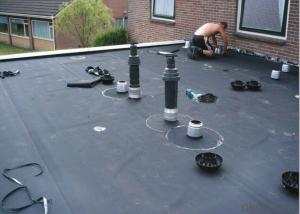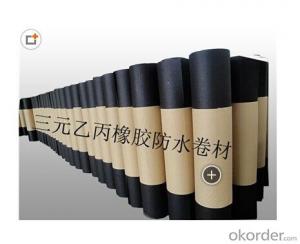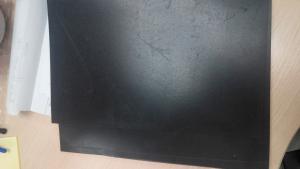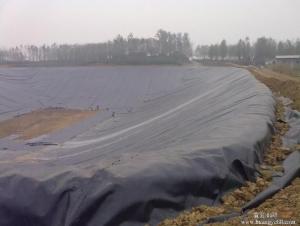EPDM Rubber Material Waterproof Membrane for Roofing Project
- Loading Port:
- Shanghai
- Payment Terms:
- TT OR LC
- Min Order Qty:
- 50000 m²
- Supply Capability:
- 5000000 m²/month
OKorder Service Pledge
OKorder Financial Service
You Might Also Like
EPDM Rubber Material Waterproof Membrane for Roofing Project
Description Of EPDM Rubber Material Waterproof Membrane for Roofing Project:
This waterproof coiled material is of high elasticity with best performance among high polumer waterproof coiled material in the world.It is also the most typical one in the world.Waterproof coiled material made of ternary ethylene-propylene rubber is produced with the use of the most advanced contiuous extrusion and vulcanization technology and related equipments which are specially designed for production of such product.It is good in compactness,without bubble and performance difference in length and breadth,perfomances reach or exceed the demands of GB18173.1-2000 standard.
Main Features of EPDM Rubber Material Waterproof Membrane for Roofing Project:
1.EPDM waterproof membrane for bridge engineering waterproof
2.EPDM waterproof membrane for water conservancy projects ,such as river bank,lake dam seepage.
3.EPDM waterproof membrane for the municipal engineering.
4.EPDM waterproof membrane for aquaculture.
Specifications of EPDM Rubber Material Waterproof Membrane for Roofing Project:
| Number | Item | Unit | Value | |
| 1 | Size Variation | Thichness | % | ±10 |
| Width | % | ±1 | ||
| Length | % | Allowed negative | ||
| 2 | Breaking tensile strength at normal temperature | Mpa | ≥7.5 | |
| Breaking tensile strength at 70°C | Mpa | ≥2.3 | ||
| 3 | Breaking elongation at normal temperature | % | ≥450 | |
| Breaking elongation at -20°C | % | ≥200 | ||
| 4 | Tear strength | KN/m | ≥25 | |
| 5 | Impermeability(30min) | * | 0.3Mpa no leakage | |
| 6 | Bending at low tempreture | °C | ≤-40 | |
| 7 | Stretch tensor at heating | Elongate | mm | ≤2 |
| Shrink | mm | ≤4 | ||
| 8 | Air oven aging(80°C×168h) | Tensile strength at break retained | % | ≥80 |
| Elongation at break retained | % | ≥70 | ||
| 9 | Anti-alkali | Tensile strength at break retained | % | ≥80 |
| Elongation at break retained | % | ≥80 | ||
| 10 | Nuture weathing at manual simulation | Tensile strength at break retained | % | ≥80 |
| Elongation at break retained | % | ≥70 | ||
Applications of EPDM Rubber Material Waterproof Membrane for Roofing Project:
Widely used in roofs, basement, toilet ,swimming pool, and all kinds of industry and civil building waterproofing, reservoir, vivicism, bridge, underground, tunnel and dam waterproofing ,especially to the keystone waterproofing projects which is durability, high corrosion resistance and easy deformation.

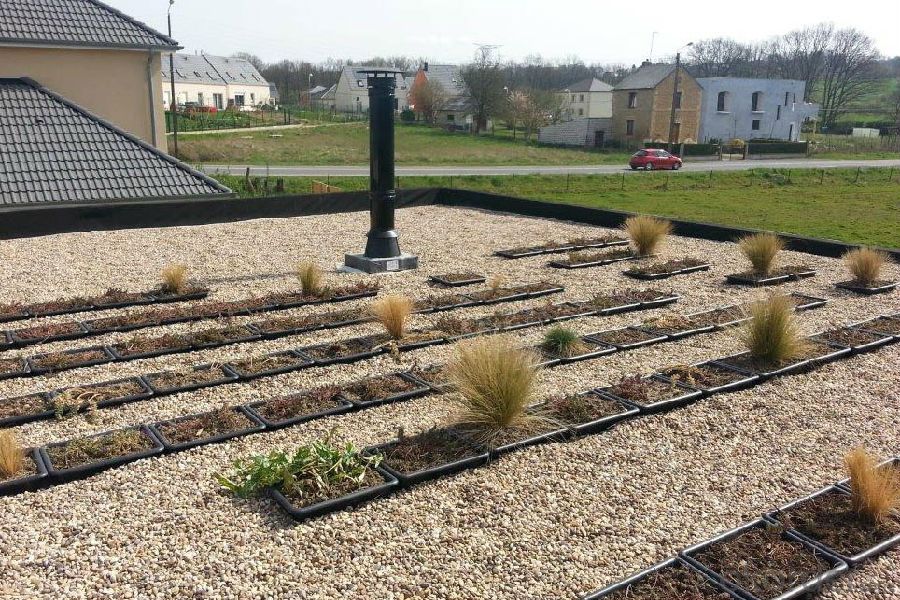

IMages of EPDM Rubber Material Waterproof Membrane for Roofing Project:
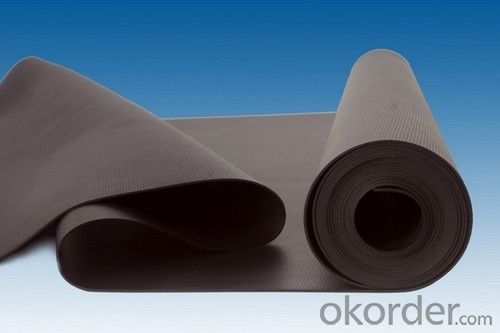
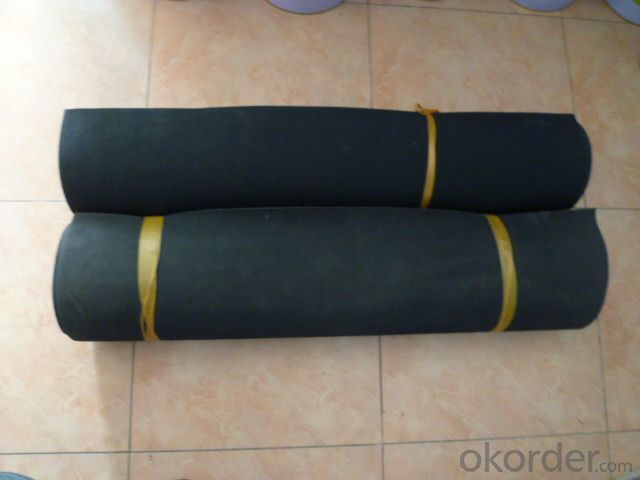


FAQ of EPDM Rubber Material Waterproof Membrane for Roofing Project:
1. What are we supplying?
We are specialized in producing Colorful Asphalt Roof Shingle, SBS/APP modified bitumen waterproof membrane, Self adhesive bitumen waterproof membrane, PVC waterproofing membrane, EPDM rubber roofing membrane, Single Component Polyurethane Waterproof Coating, and Spray Polyurea Waterproof Coating
.
2. How Many years experience do we have?
We have been exported to more than 20 countries in the past 15 years.
3. How long do we usually reply your request?
We always reply our customer within 24 hours.
- Q: The difference between high polymer modified asphalt waterproofing membrane and sbs
- SBS modified asphalt waterproofing membrane is a kind of polymer modified asphalt waterproofing membrane, which is included with the included relationship.
- Q: Are waterproofing membranes resistant to punctures?
- Waterproofing membranes are created to resist punctures. These membranes are typically constructed from strong materials like polyvinyl chloride (PVC), thermoplastic olefin (TPO), or ethylene propylene diene terpolymer (EPDM), which are renowned for their durability and ability to endure external pressures. Moreover, polyester or fiberglass is often incorporated into the waterproofing membranes to further strengthen their resistance to punctures. Nevertheless, it is crucial to acknowledge that while these membranes are designed to be highly resistant to punctures, they can still be vulnerable to damage if exposed to sharp objects or excessive force. Therefore, it is imperative to handle and install these membranes with caution in order to uphold their integrity and effectiveness.
- Q: What is a waterproofing membrane?
- A waterproofing membrane is a thin layer or sheet of material that is applied to a surface to prevent the passage of water or moisture. It is commonly used in construction, particularly in areas where water infiltration is a concern, such as roofs, basements, and bathrooms. The membrane acts as a barrier, preventing water from seeping through and causing damage to the underlying structure. It can be made from various materials, including rubber, bitumen, or synthetic polymers, and is typically applied in multiple layers to enhance its effectiveness. Waterproofing membranes are designed to be flexible, durable, and resistant to environmental factors such as UV radiation and temperature fluctuations. They are an essential component in ensuring the longevity and integrity of buildings by keeping them dry and protected from water-related issues like leaks, mold, and deterioration.
- Q: Can a waterproofing membrane be used in conjunction with warranty or insurance policies?
- Yes, a waterproofing membrane can typically be used in conjunction with warranty or insurance policies. Many waterproofing products and systems come with warranties that provide coverage for a certain period of time, typically ranging from 5 to 20 years or more. These warranties often guarantee the effectiveness and durability of the waterproofing membrane, and may cover repairs or replacements in case of any failures or defects. Additionally, insurance policies may also provide coverage for damages caused by water leaks or flooding. By installing a waterproofing membrane, property owners can mitigate the risk of water damage and potentially reduce their insurance premiums. It is advisable to check with your insurance provider to determine if they offer any discounts or incentives for using waterproofing systems. However, it is important to note that the coverage provided by warranties and insurance policies may vary depending on the specific terms and conditions. It is recommended to carefully review the details of the warranty or insurance policy and consult with professionals to ensure that the waterproofing membrane meets the requirements and specifications outlined by these agreements.
- Q: Can a waterproofing membrane be used on underground parking structures?
- Yes, a waterproofing membrane can be used on underground parking structures. These membranes are specifically designed to prevent water infiltration and are commonly used in below-grade applications such as underground parking garages to protect the structure from water damage and moisture-related issues.
- Q: Can a waterproofing membrane be used for a residential building facade?
- Yes, a waterproofing membrane can be used for a residential building facade. A waterproofing membrane is a material that is applied to the exterior surface of a building to prevent water penetration and protect the underlying structure from moisture damage. This can be particularly useful for residential buildings where the facade is exposed to various weather conditions. Using a waterproofing membrane on a residential building facade can provide several benefits. Firstly, it can prevent water from seeping through the facade and causing damage to the interior walls, insulation, and other building materials. This can help maintain a dry and comfortable living environment inside the house. Additionally, a waterproofing membrane can help increase the lifespan of the building facade by providing a protective barrier against moisture and water-related issues such as mold and mildew growth. It can also protect against efflorescence, a condition where minerals from water deposits on the surface of the facade, causing discoloration and deterioration over time. Furthermore, a waterproofing membrane can be beneficial in improving the energy efficiency of a residential building. By preventing water infiltration, it can help maintain proper insulation and prevent air leakage, reducing the energy required for heating or cooling the building. However, it is important to choose the appropriate type of waterproofing membrane for the specific requirements of the residential building facade. There are various options available, such as liquid-applied membranes, sheet membranes, and spray-applied membranes, each with their own advantages and limitations. It is advisable to consult with a professional waterproofing contractor or architect to determine the most suitable membrane system for the specific project. Additionally, proper installation and regular maintenance are essential to ensure the effectiveness and longevity of the waterproofing membrane on the residential building facade.
- Q: Is a waterproofing membrane resistant to saltwater or other corrosive substances?
- Waterproofing membranes, in general, have the ability to resist saltwater and other substances that cause corrosion. These membranes are created to act as a barrier against moisture and water intrusion, offering protection against corrosive agents. The materials commonly used to manufacture these membranes, such as modified bitumen, PVC, EPDM, or TPO, naturally possess resistance to saltwater and other corrosive elements. Some manufacturers may even add extra layers or coatings to further enhance the membrane's ability to resist corrosive substances. Nevertheless, it is important to consider that the degree of resistance can vary depending on the specific type and quality of the waterproofing membrane employed. Therefore, it is crucial to select a high-quality membrane that is specifically designed for the intended application, whether it be in saltwater environments or areas exposed to other corrosive substances.
- Q: Can a waterproofing membrane improve energy efficiency?
- Yes, a waterproofing membrane can improve energy efficiency. A waterproofing membrane acts as a barrier against moisture intrusion, preventing water from seeping into the building envelope. By keeping the structure dry, it helps to prevent the growth of mold and mildew, which can contribute to poor indoor air quality and the deterioration of building materials. In addition to protecting against moisture, a waterproofing membrane can also provide insulation benefits. Many waterproofing membranes are designed to have a high thermal resistance, or R-value. This means that they can provide an extra layer of insulation to the building, reducing heat transfer through the walls or roof. By improving the building's thermal performance, a waterproofing membrane can help to reduce the load on heating and cooling systems, resulting in energy savings and improved energy efficiency. Furthermore, a waterproofing membrane can also help to reduce air leakage in a building. Air leakage can account for a significant amount of energy loss, as conditioned air escapes through gaps and cracks in the building envelope. By sealing off these areas, a waterproofing membrane can help to improve the building's air tightness, reducing energy loss and improving energy efficiency. Overall, a waterproofing membrane can play a crucial role in improving energy efficiency by preventing moisture intrusion, providing additional insulation, and reducing air leakage. Investing in a high-quality waterproofing system can lead to long-term energy savings, improved indoor comfort, and a more sustainable and efficient building.
- Q: How does a waterproofing membrane handle extreme temperature fluctuations?
- To withstand extreme temperature fluctuations, a waterproofing membrane is crafted with resistance to temperature changes. Typically, it is composed of materials that possess a high tolerance for both hot and cold temperatures. The selection of these materials is based on their capability to expand and contract without compromising their integrity or effectiveness. In hot weather, the waterproofing membrane undergoes slight expansion to accommodate the rise in temperature. This expansion serves to prevent the formation of cracks or gaps that may allow water to infiltrate the membrane. Similarly, in cold weather, the membrane contracts to prevent damage caused by freezing temperatures. The ability of a waterproofing membrane to handle extreme temperature fluctuations is also achieved through its installation process. Usually, the membrane is applied in multiple layers, creating a seamless and flexible barrier. This layered application enables the membrane to endure the strains caused by temperature changes while upholding its protective properties. Furthermore, certain waterproofing membranes are equipped with special additives or reinforcements that enhance their capacity to handle extreme temperature fluctuations. These additives provide additional strength and flexibility, ensuring the membrane remains intact and functional even in the face of severe temperature changes. Ultimately, a properly installed and maintained waterproofing membrane is intended to handle extreme temperature fluctuations by expanding and contracting, maintaining its integrity, and delivering a consistent barrier against water intrusion.
- Q: Are there any specific installation techniques for corners and edges when using a waterproofing membrane?
- Yes, when installing a waterproofing membrane on corners and edges, it is important to follow specific techniques. First, ensure that the membrane extends beyond the corner or edge by at least 6 inches to provide adequate coverage. Next, carefully fold and crease the membrane to create a tight seal around the corner or edge. Use a heat gun or adhesive to secure the folded membrane in place. Additionally, apply a layer of sealant or waterproofing tape over the folded membrane to further reinforce the corner or edge. These techniques help prevent water penetration and ensure effective waterproofing in these vulnerable areas.
Send your message to us
EPDM Rubber Material Waterproof Membrane for Roofing Project
- Loading Port:
- Shanghai
- Payment Terms:
- TT OR LC
- Min Order Qty:
- 50000 m²
- Supply Capability:
- 5000000 m²/month
OKorder Service Pledge
OKorder Financial Service
Similar products
Hot products
Hot Searches
Related keywords
